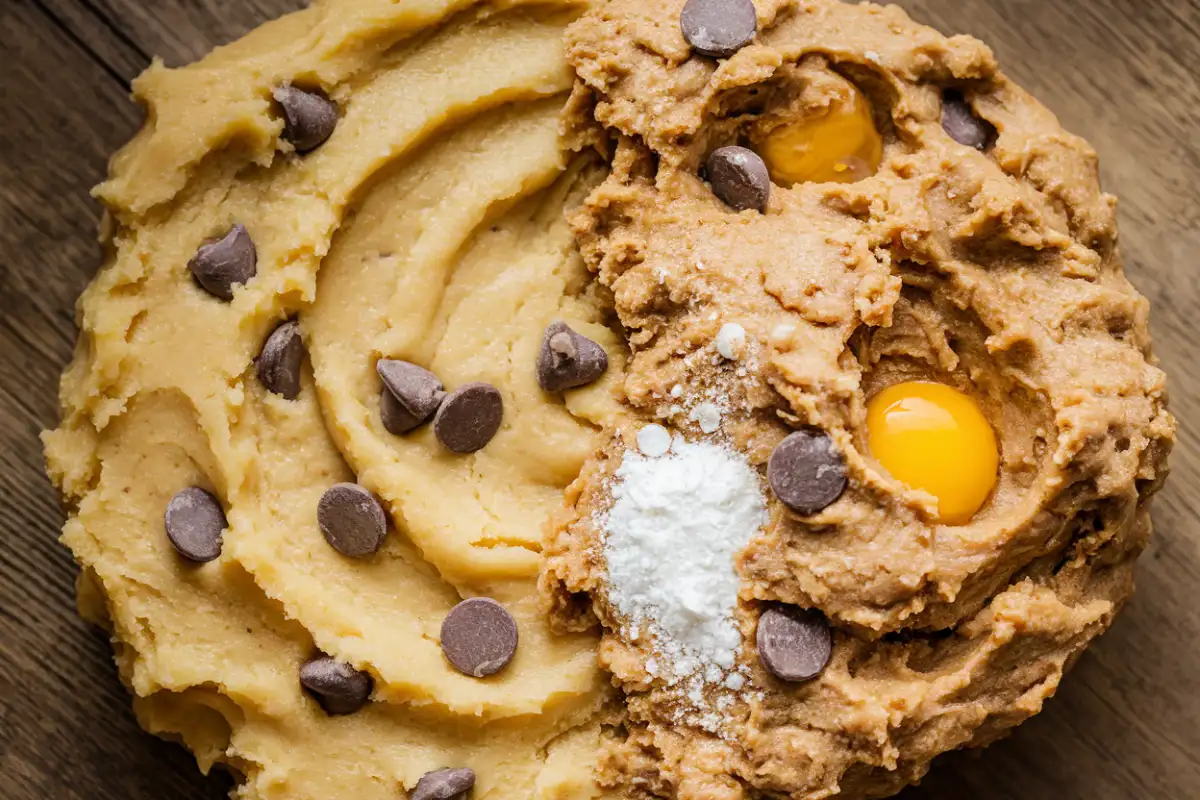If you’ve spent time baking cookies, you’ve probably come across two terms: “cookie batter” and “cookie dough.” These terms are often used interchangeably, but they actually describe two distinct stages in the cookie-making process. Understanding the difference between cookie batter and cookie dough can help you improve your baking skills and ensure that your cookies turn out just right.
In this article, we’ll explore the differences between cookie batter and cookie dough, discuss their unique characteristics, and provide tips for working with both. By the end, you’ll have a better understanding of these two stages and how to handle them properly in your kitchen.
What is Cookie Batter?
Cookie batter refers to the initial mixture of wet and dry ingredients before the dough starts to form. The term “batter” is often associated with liquids or semi-liquids. For cookies, it is the mixture in its early stage before it becomes more structured.
Characteristics of Cookie Batter
- Consistency: Cookie batter is typically thinner and more fluid compared to dough. It’s similar to cake batter, where the mixture still flows easily but has started to incorporate flour.
- Ingredients: Cookie batter contains all the same ingredients as dough—flour, sugar, butter, eggs, and sometimes add-ins like chocolate chips—but at this stage, the ingredients have not yet formed a cohesive dough.
- Stirring and Mixing: Cookie batter often requires a bit more mixing to properly blend the ingredients. Overmixing can sometimes lead to dense or tough cookies, but it’s necessary to reach this stage before transitioning to dough.
At the batter stage, the mixture isn’t ready to be shaped into cookies. Instead, it’s a prelude to dough, which forms after further mixing and processing.
What is Cookie Dough?
Cookie dough, on the other hand, is a more solid and malleable form of the cookie mixture. Once the flour fully absorbs the wet ingredients (such as eggs, butter, and sugar), the mixture becomes firm enough to shape into individual cookies. Dough can be easily handled, rolled, scooped, or formed into cookie shapes.
Characteristics of Cookie Dough
- Consistency: Cookie dough is much firmer and more structured than batter. It holds its shape when scooped or rolled and is often thick enough to mold into balls or logs.
- Texture: Dough has a smooth but pliable texture. It’s soft to the touch but should be firm enough to not stick to your hands excessively.
- Handling: Cookie dough can be worked with directly, allowing bakers to form it into various shapes. This is the stage when you scoop it onto baking sheets, roll it out for cut-out cookies, or refrigerate it for specific recipes.
Once cookie dough has formed, it is ready to be baked, frozen, or shaped according to the recipe’s instructions.
Differences Between Cookie Batter and Cookie Dough
While cookie batter and cookie dough share many of the same ingredients, they are distinct in several key ways. Below are some major differences between the two:
1. Consistency
- Batter: Cookie batter has a looser, more liquid-like consistency. It will often pour or drop off a spoon, but it isn’t firm enough to hold its shape.
- Dough: Cookie dough, by contrast, is much thicker. It holds its shape when formed into balls or other shapes and is firm enough to be molded without spreading too much on its own.
2. Stage of Preparation
- Batter: The batter is created at the beginning of the cookie-making process when wet and dry ingredients are first mixed together. It’s the intermediate step between combining ingredients and forming dough.
- Dough: Dough is the final stage before baking. Once the batter thickens and becomes cohesive, it transforms into dough, which is then shaped and prepared for the oven.
3. Handling and Shaping
- Batter: Due to its loose texture, cookie batter is not easily shaped or handled. It’s often left to firm up through mixing or chilling before it can be worked with.
- Dough: Cookie dough is much more manageable. It can be scooped into rounds, rolled out for cookie cutters, or dropped onto a baking sheet. It’s ready for shaping and baking.
4. Spread and Structure in Baking
- Batter: If you were to bake cookie batter as is, it would likely spread out too much and result in thin, flat, or even misshapen cookies. Batter needs to transform into dough to hold its structure.
- Dough: Cookie dough, on the other hand, holds its form when baked, resulting in well-shaped cookies. The dough’s firmness prevents excessive spreading, allowing the cookies to bake evenly.
The Role of Ingredients in the Transition from Batter to Dough
One of the biggest factors that differentiate cookie batter from cookie dough is how the ingredients interact during the mixing process. Let’s explore how the key ingredients contribute to the transition from batter to dough.
1. Flour
Flour is the most important ingredient in transforming batter into dough. When flour is added to the batter, it absorbs moisture and begins to form gluten, which gives structure to the dough. The more you mix and hydrate the flour, the firmer the dough becomes.
2. Butter and Fats
The fat in the butter helps bind the dough together. In cookie batter, the butter is still somewhat dispersed in the mixture. As the ingredients mix and the flour absorbs the fat, the mixture starts to firm up, resulting in dough.
3. Sugar
Sugar plays a critical role in both the flavor and texture of cookies. In the batter stage, sugar is still dissolving and integrating with the other ingredients. As the dough forms, the sugar continues to dissolve, adding to the structure and sweetness of the final dough.
4. Eggs
Eggs provide moisture and help hold the ingredients together. In the batter stage, the eggs are fully incorporated but still contribute to the loose consistency. As the batter transforms into dough, the eggs help bind the flour and fat, creating a cohesive mixture.
Tips for Working with Cookie Batter and Dough
Whether you’re working with cookie batter or cookie dough, there are a few key tips that can help you achieve the best results.
1. Don’t Overmix
While mixing is essential for combining ingredients, overmixing can lead to tough cookies. When working with cookie batter, mix just until the ingredients are combined. Overmixing develops too much gluten, which can make the cookies dense and chewy instead of light and soft.
2. Chill the Dough
If your batter is too loose, or you want your cookies to spread less in the oven, refrigerating the dough before baking is a great idea. Chilling the dough allows the fats to solidify, leading to less spreading and a chewier texture.
3. Use the Right Tools
When transitioning from cookie batter to dough, using the right tools can make all the difference. A hand mixer or stand mixer is great for incorporating ingredients evenly, and a cookie scoop ensures uniform dough balls for even baking.
4. Bake Dough, Not Batter
Never bake cookie batter directly. It’s important to let the mixture form into dough first. This ensures that your cookies will bake properly and maintain their shape, texture, and structure.
Common Types of Cookie Dough and Batter
Depending on the type of cookies you’re making, the transition from batter to dough can vary. Let’s take a look at how this process differs for some popular cookie types:
1. Chocolate Chip Cookies
- Batter: The batter for chocolate chip cookies starts loose and gradually firms up as the flour absorbs moisture.
- Dough: Once the dough forms, it’s firm enough to scoop into balls and bake. Many recipes recommend chilling the dough before baking to enhance flavor and prevent excessive spreading.
2. Sugar Cookies
- Batter: Sugar cookie batter is soft and smooth when first mixed.
- Dough: Sugar cookie dough is typically chilled before being rolled out and cut into shapes. Chilling ensures the dough holds its form and doesn’t spread too much.
3. Oatmeal Cookies
- Batter: Oatmeal cookie batter is wetter than most, due to the oats and any add-ins like raisins or nuts.
- Dough: The dough firms up as the oats absorb moisture, creating a thick, chewy texture when baked.
Why Understanding the Difference Matters

Knowing the difference between cookie batter and cookie dough is important for both beginners and seasoned bakers. When you understand the science behind how the ingredients work together, you can control the outcome of your cookies more effectively.
For example:
- If your cookie batter is too runny, you might need to add more flour to reach the dough stage.
- If your dough is too firm, you might need to let it rest or add a little more liquid to loosen it up.
The next time you bake cookies, you’ll have a better grasp of what stage your mixture is at and how to adjust it for the perfect cookies.
Conclusion
While cookie batter and cookie dough are often used interchangeably, they are two distinct stages in the cookie-making process. Batter is the initial mixture of wet and dry ingredients, while dough forms after further mixing, allowing the ingredients to come together in a cohesive, malleable form. The transition from batter to dough is crucial for achieving the perfect cookies, and understanding how to work with both can greatly improve your baking skills.
Next time you whip up a batch of cookies, take a moment to appreciate the transformation from loose batter to structured dough. It’s the key to creating delicious, perfectly shaped cookies every time!

